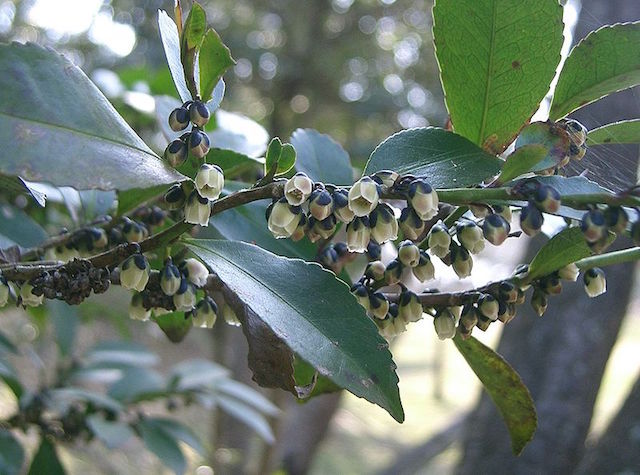The unseen power of tiny ecosystems
Sex differences in male and female plants raise some big questions
Jessica Romeo • February 13, 2019

Researchers have observed that Eurya japonica interacts differently with fungi and bacteria based on sex [Credit: KENPEI, Wikipedia | Creative Commons]
Studying the sex of a plant is surprisingly unsexy.
It’s certainly not glamorous work. For three years, Kaoru Tsuji worked from a makeshift lab in her kitchen, analyzing nectar from a local plant called Eurya japonica. This tall, flowering shrub grows just outside of Tsuji’s hometown near Kyoto in Japan, and has provided her with new insights into the study of sexual dimorphism.
Whereas most plants are hermaphroditic, E. japonica is sexually dimorphic: it has separate male and female plants. The difference between them is subtle; the off-white, bell-shaped flowers of the male plant are a bit larger and showier, while the flowers on the female plant are smaller, with sweeter nectar.
Tsuji’s recent study, published last September in Ecology, finds that the sex of these plants can have unexpected effects on birds, bees and the surrounding microbes.
To fully understand these wider effects, Tsuji had to start small. Microscopically small.
From her tiny, makeshift lab, Tsuji closely analyzed the interactions between the bacteria and fungi that grow on the shrub’s nectar. “I was surprised by how different the male and female can really be,” says Tsuji. She found that male nectar is more likely to attract fungi. Female nectar, on the other hand, is more likely to attract bacteria.
Researchers also uncovered antagonism between the fungi and the bacteria, explains ecologist Tadashi Fukami of Stanford University, a co-author of the study. The presence of fungi on a flower can make it more difficult for bacteria to grow. This is important because pollinators like bees and hummingbirds prefer fungi-dominated male flowers over bacteria-covered female blooms.
“Microbiology is the hot topic in ecology,” says Fukami. “Now we have the tools to look at microbes, and we’re finding that there are ways to better understand plant-pollinator interactions.”
The finding could prove useful to the study of pollination, which is vital for agriculture. Insights into the interactions among bacteria and fungi could help farmers make agricultural pollination more efficient, says Fukami. For example, some bacterial pathogens infect flowers on fruit trees by traveling through nectar. It might be possible to preemptively introduce fungi into a flower, which would hypothetically allow it to resist any future bacterial colonization.
Other applications of this research are likely, says Fangliang He, an ecologist from the University of Alberta.
“My feeling is that this story is not finished yet,” says He. If researchers can learn to manipulate the microbiome, they could significantly improve agricultural practices, optimize fertilization and better understand how ecosystems operate.
Not very sexy, but certainly very important.